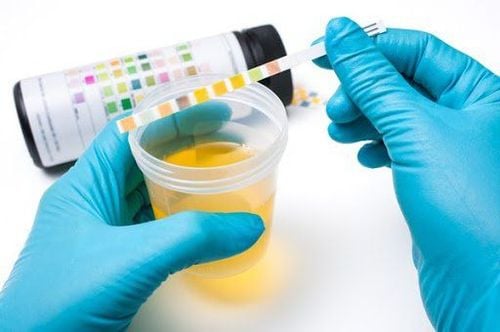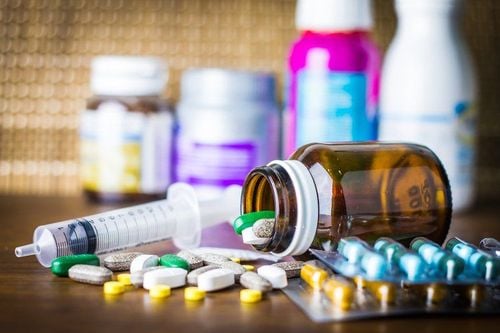This is an automatically translated article.
Meconium aspiration syndrome - MAS can occur before during or after birth, due to aspiration of amniotic fluid containing meconium, partially or completely obstructing the airways, disrupting gas exchange in the lungs and causing respiratory failure. severe breathing. So how will children inhaling meconium be treated and prevented?1. Treatment of inhalation of meconium in infants when there are any manifestations?
According to some recent recommendations, children who inhale meconium, although having good clinical manifestations, do not have gas exchange disorders, must still be closely monitored during the first 24 hours, because severe manifestations may occur. later in about 20 - 30% of cases. Children will have amniotic fluid aspirated from the oropharynx and monitored for heart rate, breathing rate and blood oxygen... When children inhale meconium, they often have severe symptoms such as:Respiratory failure Slow heart rate < 100 times/min Child has weak movements, decreased muscle tone... Doctors have to aspirate meconium amniotic fluid through endotracheal tube, the purpose is to clear meconium in the upper and lower respiratory tract, clear the airways. Open the airway and give the child oxygen. Children with severe symptoms are continued to be treated and monitored in the neonatal intensive care unit. Basic meconium inhalation treatment includes the following steps:
Oxygen or mechanical ventilation if severe respiratory failure occurs. Perform surfactant replacement therapy. Give antibiotics to fight infection. Treatment of pulmonary hypertension by specific methods. Respiratory physiotherapy. Monitor and treat complications of pneumothorax, hospital-acquired infections...

Khi trẻ hít phải phân su thường có các biểu hiện nặng như suy hô hấp, nhịp tim chậm...
2. Specific treatment regimen for MAS . meconium aspiration syndrome
2.1. Initial emergency management in the delivery room If the newborn is well - crying loudly, rosy skin, good muscle tone - there is no need for endotracheal suctioning, just aspiration of the nose and mouth if amniotic fluid is present. Perform mouth suction first, nose suction later. If the infant is unwell, immediately put the child in a warm bed, delay drying, stimulate breathing, aspirate gastric juice. Then immediately intubate the suction tube directly under the laryngoscope. Avoid mask positive pressure ventilation until endotracheal aspiration has been completed. 2.2. Subsequent management of meconium inhalation in children Respiratory support Respiratory support is an important treatment measure to maintain oxygen supply and ventilation for children who inhale meconium, especially when the child is hypoxic. blood, acidosis, and hypercapnia. This condition can increase pulmonary vascular resistance, leading to increased pulmonary artery pressure. Hyperventilation, respiratory alkalosis and trapping should be avoided.Oxygen support therapy in mild or moderate disease to keep SaO2 > 90%, maintain arterial PO2 55 - 90 mmHg to deliver oxygen to tissues and avoid lung injury. Limit hypoxia to avoid constriction of pulmonary blood vessels and increase pulmonary artery pressure. An umbilical artery catheter should be placed to monitor blood gases and blood pressure, and an umbilical vein catheter to administer fluids and medications to the child.
Supportive ventilation is indicated when there is a change in blood gases:
Give the child CPAP when oxygen requires a high concentration of 40% -50%. Note that CPAP should be used with caution in hyperventilated infants, which may have air trapping. Mechanical ventilation: The purpose of ventilatory support is to achieve maximum blood gas changes and minimize lung injury for the child. Destination to be achieved: PaCO2 50 - 55 mmHg, PaO2: 50 - 90 mmHg (SaO2 > 90%). High-frequency machines can be used in infants unresponsive to conventional ventilators, and failure of mechanical ventilation can be used with ECMO therapy. Sedation: infants with meconium aspiration syndrome may have a spontaneous respiratory rhythm that causes anti-aircraft stimulation, possibly related to catecholamine release, increased pulmonary vascular resistance, right-left shunt thickening and lowers blood oxygen. The purpose of appropriate sedation is to ensure optimal ventilation during the acute phase and to control weaning in the infant.
Intravenous Morphine sulfate: with an initial dose of 100 - 150 mcg/kg over 1 hour, then maintain an intravenous infusion of 10 - 20 mcg/kg/hour.
Intravenous Fentanyl (dose 1-5 mcg/kg/hour). If there is an anti-mechanical rhythm, especially when the cause is unknown (eg, airway obstruction or pneumothorax) the muscle relaxant Pancuronium (dose 0.1 mg/kg IV/hour) can be used, but should be limited. Avoid using this drug (if possible) because of adverse effects.
Surfactant therapy: helps reduce severe respiratory failure and reduces the need for ECMO in mechanically ventilated infants. Indicated for meconium aspirated children requiring mechanical ventilation with high FiO2 index > 50% and mean airway pressure > 10-12 cmH2O. Surfactant dosage is 150 mg/kg.
Nitric oxide (iNO): as an option for improving blood oxygenation in children associated with pulmonary hypertension. Other treatments for pulmonary hypertension are sildenafil, a phosphodiesterase inhibitor.
ECMO (Extracorporeal membrane oxygenation): used when meconium inhalation is unresponsive to mechanical ventilation, surfactant therapy and iNO. ECMO provides cardiopulmonary support, reducing the risk of lung injury from mechanical ventilation and the use of high oxygen concentrations.
Support circulation Ensure proper cardiac output and tissue perfusion, including:
Maintain good circulatory volume, increase circulating volume with 0.9% normal saline in children with low blood pressure and poor peripheral perfusion. Stop feeding in case of severe respiratory failure, maintain parenteral nutrition for the first 24 hours after birth with volume restriction to 65ml/kg, including 5% sugar and no electrolytes. Red blood cell transfusions may be used to increase tissue perfusion, especially in infants with low oxygen. In general, it is necessary to maintain a hemoglobin concentration above 15g/dL (hematocrit above 40-45% in children with severe MAS.Vopressors can be used to support blood pressure in children with pulmonary hypertension.Depamine is a drug. Usually selected, starting with 2.5 - 10 mcg/kg/min IV, the dose may be increased to maintain mean blood pressure at a level that is likely to minimize right-left shunting. Because the infection is high and it is difficult to distinguish between meconium aspiration syndrome and bacterial pneumonia, the doctor will start giving broad-spectrum antibiotics Ampicillin and Gentamicin while waiting for the results of blood cultures. Evidence of the effectiveness of corticosteroid therapy in children with meconium aspiration . Therefore, corticosteroid therapy in children with meconium inhalation is not recommended.
Other treatments: Anti-acidosis Maintain body temperature Treat accompanying symptoms
3. How to prevent children from inhaling meconium

Những bà mẹ mà thai kỳ có nguy cơ cao cần khám thai định kỳ
Please dial HOTLINE for more information or register for an appointment HERE. Download MyVinmec app to make appointments faster and to manage your bookings easily.













